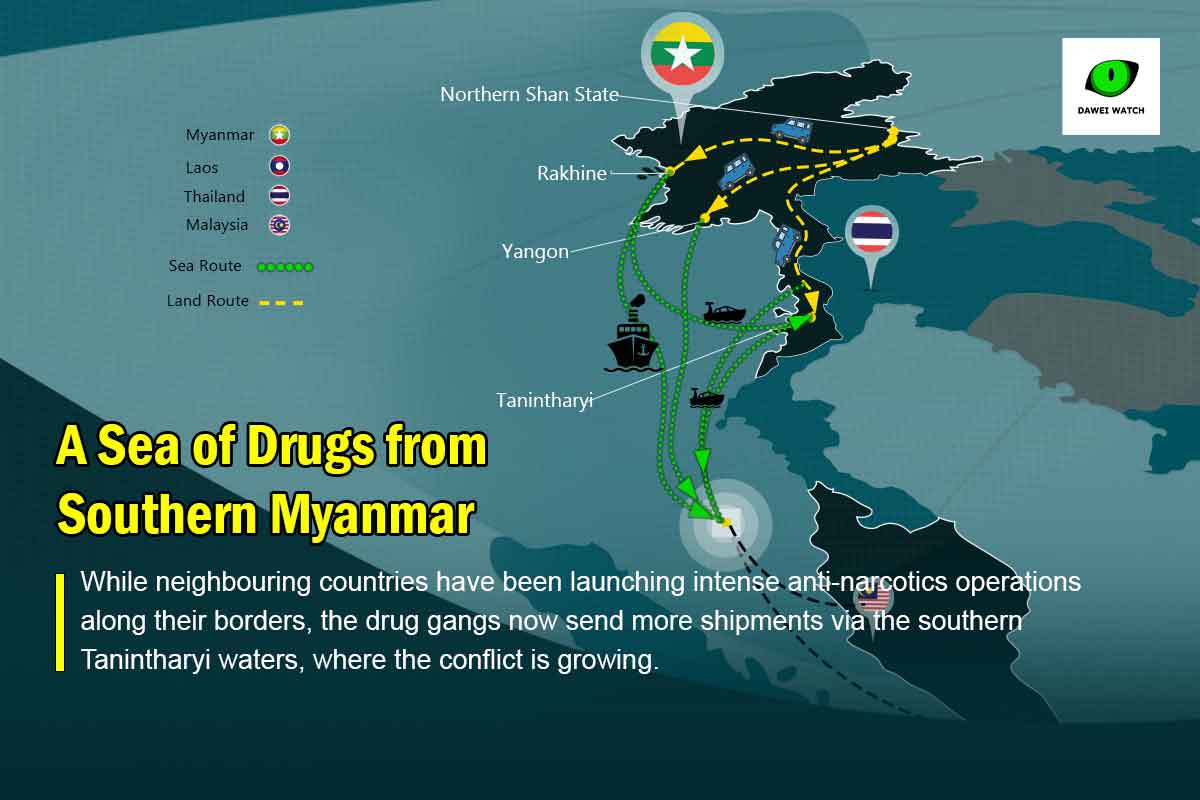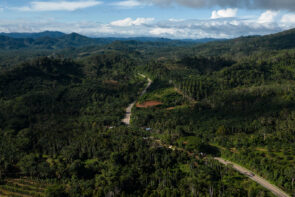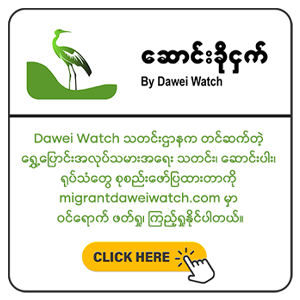While neighboring countries have been launching intense anti-narcotics operations along their borders, the drug gangs now send more shipments via the southern Tanintharyi waters, where the conflict is growing.
Dawei Watch
When more than one ton of methamphetamine – commonly known as ice – was found aboard a fishing boat by Myanmar’s military junta in February, the drug bust highlighted a new route for trafficking out of the Golden Triangle.
The vessel, disguised as a fishing boat, was carrying drugs that had come by land and river from northern Shan state, according to the sailors on board. The final destination was Malaysia. However, the boat was intercepted 190 miles from Kawthaung in Thanintharyi waters in the south of Myanmar, and the drug haul was valued at more than 40 billion Kyats (US$19 million).
The seized boat was only one of many believed to be carrying drugs from the region.
Vacuum of territorial waters
While neighbouring countries have been launching intense anti-narcotics operations along their borders, the drug gangs now send more shipments via the southern Tanintharyi waters, where the conflict is growing. The United Nations Office on Drugs and Crime (UNODC) confirmed that drug-smuggling gangs now use more sea routes to traffic narcotics from Myanmar.
An experience businessman in the fishing industry and a police officer who Dawei Watch interviewed also confirmed this information. “(The drugs go) along the sea route. They use boats along Myeik and Kawthaung,” said the police officer.
Most of the methamphetamine (ice) has for years been produced in the Golden Triangle where the borders of Thailand, Laos and Myanmar converge. Narcotics produced in the Golden Triangle, including ice and yaba pills, were trafficked in huge amounts through routes in Laos and northern Thailand in the past.
Recently, an increase in arrests and interrogations has been reported along the border with Yunnan province in China and along the Thai border, according to a UNODC report. Because of this increase in arrests along the borders, drug gangs have now switched to shipping their products by sea, taking advantage of the lawless vacuum caused by the military coup.
Representative of the Southeast Asia and Pacific Region UNODC said the main new drug smuggling route was heading to the Andaman Sea, via central Myanmar. Narcotics trafficking in Asia has grown enormously because of these new trafficking routes, according to a new UNODC report released on June 9.
There have been frequent arrests and seizures of billions of Kyats worth of ice and yaba on the Tanintharyi Sea.
Since the military coup in Myanmar in February 2021 up until April 2024, five times more boats have been caught carrying narcotics in the Tanintharyi Sea. The big seizures were worth billions of Kyats – the smaller seizures worth less than one billion Kyats were not even counted.
The number of seizures made was according to figures released by the Central Committee on Prevention of Narcotic Drugs and Psychotropic Substances (CCDAC Myanmar) and is thought to be just the tip of the iceberg.
Using new routes
The narcotics were mainly trafficked by two routes, according to arrests made on the sea, and according to data from CCDAC Myanmar.
The first route involves carrying the drugs by land from northern Myanmar, where they are mainly produced, to Myeik or Kawthaung. From there the drugs are taken by local fishing boats to Malaysia’s territorial waters, where buyers await.
The second route is to carry the drugs by land from northern Myanmar to Ayeyarwaddy Division or Yangon Division or Rakhine State, and then they are sent on motorboats to Malaysian waters.
A businessman from Tanintharyi region with extensive interests in the fishing industry, who owned many fishing boats and ran a business there for about three decades, said the drug gangs were transporting their goods using local fishing boats to go into Malaysian waters.
Big boats more than 12 feet wide were used for drug trafficking, he told Dawei Watch. One of the reasons the traffickers chose boats from the Tanintharyi region was that the boats there were all the same because they were built based on a design from Thailand, and they could go unnoticed when mixing with other fishing boats.
“As far as I know, they come as far as to Myeik by land. Myeik is a meeting point. They look for a boat in Myeik,” said the businessman.
When they carry drugs from Myeik, they buy local fishing boats for that purpose, or they work in collaboration for mutual benefits.
“They will give you a good sum of money. They want to go to so and so latitude and longitude. They will tell you how much they will pay. It’s like carrying goods. You have to provide a helmsman, a mechanic and sailors. You have to transport the goods,” said the businessman.
Narcotics worth millions of Kyats have also been seized from some fishing boats in Myeik township.
In January 2020, ice worth more than 20 billion Kyats ($9.5 million) was seized from a boat tied up at a dock in Kywae-Ku village in Myeik township, where most of the sea-going fishing boats dock.
Early this year, a motorboat owned by a local from Myeik was stopped at sea near Haing-Gyi island and a large haul of ice was seized.
The military junta also captured a boat named Aye Myat Aung while it was waiting at sea near Haing-Gyi island for a ship from Malaysia. That boat belonged to fishing businessman U Tin Shein, from Myeik, and it was seized while it was waiting to unload one and a half tons of ice it had picked up from a warehouse in Thamban-Chaing village in Pathein Township, Irrawaddy region.
Before the coup, narcotics sent to be distributed via Malaysia went through Tanintharyi region by land and sea. For example, nearly 1.2 tons of methamphetamine was seized in a container sent by sea to Malaysia from a Myanmar port in 2018. Malaysian authorities seized the container and arrested three Malaysians and three Myanmar nationals.
Hundreds of packages of ice packed in tea sacks once floated in the sea in the Tanintharyi region. The ice packed in tea sacks had printing on them with Chinese characters and were driven ashore by the tide. Local fishermen also saw many floating in the sea.
A tea sack containing one kilogram of ice was found in June 2019, when fishing in the sea was banned. Fishermen assumed the drug packages were floating because either the boat capsized or the packages were thrown into the water by those who feared being searched by patrol boats.
Although it is not known why the packages were floating in the sea, it was undeniable proof that narcotics were being transported on a great scale across the Andaman sea.
At the time, police officers from Tanintharyi confirmed the story.
The sea in Tanintharyi Division was being used to transport narcotics from northern Myanmar to the world, according to Police-Major Nay Myo, who served as Division Chief of Police under the NLD government.
Occupation after the coup
While it has been lawless because of battles and conflicts since the military coup, the drug trading routes across the Tanintharyi sea have become wider. According to recent arrests, the seizure of narcotics worth billions of Kyats have become frequent.
Narcotics were also being transported in speedboats from the shore along the Tanintharyi coast to big boats out at sea, a three-star police officer in Tanintharyi region told Dawei Watch. These speedboats were shuttling between the shore in Kawthaung, the southernmost part of Myanmar, and the big boats waited in the sea, he said.
“They had small Johnson-powered (speedboats). They send the drugs out to sea,” said the police officer.
At the end of 2022 after the military coup, one ton of ice about to be sent to a boat in the Andaman Sea was seized in Myeik. Those drugs were carried in cars from Shan State and would be sent to a boat in the sea, said the military junta’s committee involved in controlling drug abuse.
Under the U Thein Sein government and NLD government, an anti-narcotics group controlled directly by the president was formed and a safe communication channel was opened for complaints.
That group disappeared after the coup. The seizure of narcotics had been going down because of internal conflicts and battles.
Although the police knew that drugs had been transported from the coast, they dared not make arrests due to revolutionary battles and conflicts.
“It is more difficult to make arrests than the past. We dare not go fearlessly. We have to check the security status,” he said.
It has been at least a decade since narcotics have been transported to international markets via the Tanintharyi Division or Tanintharyi Sea, the veteran marine entrepreneur said. Drugs would move in fishing boats from Tanintharyi Division to Thailand and Malaysia. Then drugs would spread in cargo ships to Japan, South Korea, Taiwan and Australia, the Japan-based Nikkei Asia reported in a news feature recently.
He also commented that the smooth transportation of narcotics on the Tanintharyi coast would be impossible without the involvement of authorities, including anti-narcotics police and intelligence personnel.
“It’s impossible to trade drugs without the police. Arrests are made only when negotiations for payment fail,” he said.







